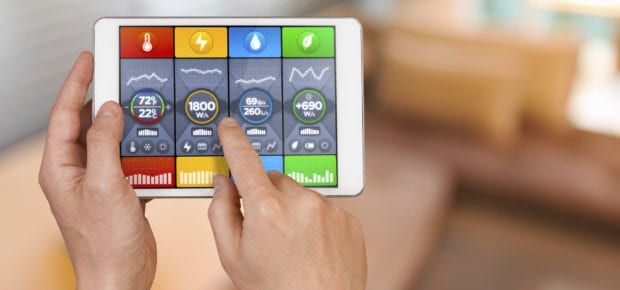July 14, 2015
The smart home is now a reality. With a range of products on the market, consumers are more often limited by their imaginations than the technology itself.
The smart home is now a reality. With a range of products on the market, consumers are more often limited by their imaginations than the technology itself. Systems from a range of manufacturers allow us to control doors, lights, appliances, thermostats and security systems from multiple devices, whether we’re at home or halfway around the world. In fact, nowadays the smart home is more about effective device and object management than technology itself, with various brands, connectivity protocols and interfaces vying for prominence.
This begs the question of how smart a home can really be.
For some, the Internet of Things (IoT) is as dazzling as it is daunting. With every fantasy of a completely automated living space comes the nightmare of a connected home in revolt, an apocalyptic vision of machines turning against humans and taking over the world. And while an automated takeover is extremely unlikely, there is an ever-present risk of human interference in the way of hackers and cyber thieves who will inevitably try to compromise systems.
A Balancing Act
All things considered, which is more likely? A physical home break-in or an electronic hack? Do we forego health sensors that can alert first responders in an emergency for fear that our personal health data could be exposed to cyberterrorists? Do we keep money under the mattress or in the bank? It’s all a matter of personal comfort. More often than not, consumers will customize their connected homes to fit their preferences. The important thing is the technology is fully capable of this.
The real power of the connected home lies in its ability to learn and predict our behavior such that our living spaces naturally conform to our moods and cycles. We set the lights one way for when we wake up and another way for when we arrive home at night. We play party music on Saturday nights and chillout beats on Sunday. Or maybe our wearable sleep monitors can adjust room temperature and sound machines to calm a restless mind. Ultimately we have the freedom to manage connected devices and the creativity to bring them into concert. We can put a sensor on just about anything. It’s up to us to decide how to leverage them.
When we think of it in these terms, the connected home is pretty smart after all.





 Impact of Technology in 2024
Impact of Technology in 2024 Emerging AI Cybersecurity Challenges and Solutions
Emerging AI Cybersecurity Challenges and Solutions The Skies are Unlimited
The Skies are Unlimited Smart Cities 2030: How Tech is Reshaping Urbanscapes
Smart Cities 2030: How Tech is Reshaping Urbanscapes Impact of Technology 2023
Impact of Technology 2023 Cybersecurity for Life-Changing Innovations
Cybersecurity for Life-Changing Innovations Smarter Wearables Healthier Life
Smarter Wearables Healthier Life Infrastructure In Motion
Infrastructure In Motion The Impact of Tech in 2022 and Beyond
The Impact of Tech in 2022 and Beyond Cybersecurity, Technology and Protecting Our World
Cybersecurity, Technology and Protecting Our World How Technology Helps us Understand Our Health and Wellness
How Technology Helps us Understand Our Health and Wellness The Resilience of Humanity
The Resilience of Humanity Harnessing and Sustaining our Natural Resources
Harnessing and Sustaining our Natural Resources Creating Healthy Spaces Through Technology
Creating Healthy Spaces Through Technology Exceptional Infrastructure Challenges, Technology and Humanity
Exceptional Infrastructure Challenges, Technology and Humanity The Global Impact of IEEE's 802 Standards
The Global Impact of IEEE's 802 Standards Scenes of our Cyber Lives: The Security Threats and Technology Solutions Protecting Us
Scenes of our Cyber Lives: The Security Threats and Technology Solutions Protecting Us How Millennial Parents are Embracing Health and Wellness Technologies for Their Generation Alpha Kids
How Millennial Parents are Embracing Health and Wellness Technologies for Their Generation Alpha Kids Space Exploration, Technology and Our Lives
Space Exploration, Technology and Our Lives Global Innovation and the Environment
Global Innovation and the Environment How Technology, Privacy and Security are Changing Each Other (And Us)
How Technology, Privacy and Security are Changing Each Other (And Us) Find us in booth 31506, LVCC South Hall 3 and experience the Technology Moon Walk
Find us in booth 31506, LVCC South Hall 3 and experience the Technology Moon Walk Virtual and Mixed Reality
Virtual and Mixed Reality How Robots are Improving our Health
How Robots are Improving our Health IEEE Experts and the Robots They are Teaching
IEEE Experts and the Robots They are Teaching See how millennial parents around the world see AI impacting the lives of their tech-infused offspring
See how millennial parents around the world see AI impacting the lives of their tech-infused offspring Take the journey from farm to table and learn how IoT will help us reach the rising demand for food production
Take the journey from farm to table and learn how IoT will help us reach the rising demand for food production Watch technical experts discuss the latest cyber threats
Watch technical experts discuss the latest cyber threats Explore how researchers, teachers, explorers, healthcare and medical professionals use immersive technologies
Explore how researchers, teachers, explorers, healthcare and medical professionals use immersive technologies Follow the timeline to see how Generation AI will be impacted by technology
Follow the timeline to see how Generation AI will be impacted by technology Learn how your IoT data can be used by experiencing a day in a connected life
Learn how your IoT data can be used by experiencing a day in a connected life Listen to technical experts discuss the biggest security threats today
Listen to technical experts discuss the biggest security threats today See how tech has influenced and evolved with the Games
See how tech has influenced and evolved with the Games Enter our virtual home to explore the IoT (Internet of Things) technologies
Enter our virtual home to explore the IoT (Internet of Things) technologies Explore an interactive map showcasing exciting innovations in robotics
Explore an interactive map showcasing exciting innovations in robotics Interactively explore A.I. in recent Hollywood movies
Interactively explore A.I. in recent Hollywood movies Get immersed in technologies that will improve patients' lives
Get immersed in technologies that will improve patients' lives